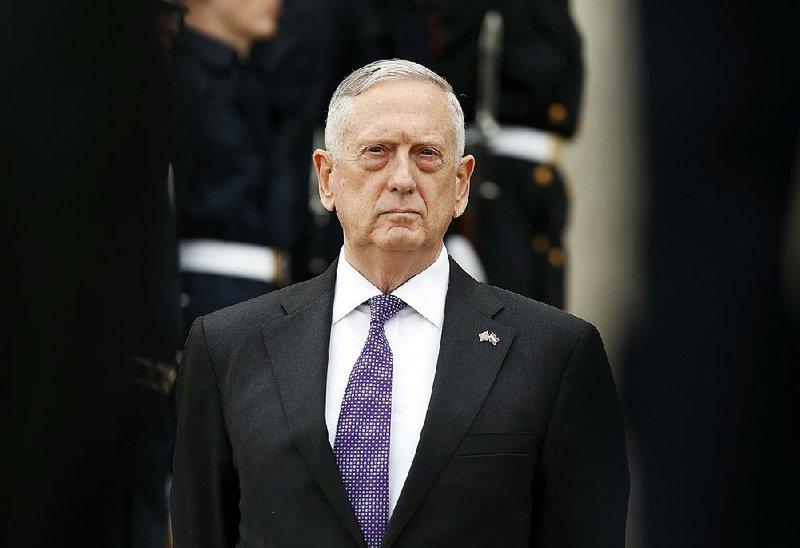WASHINGTON -- The Pentagon has begun sending additional troops to Afghanistan to carry out President Donald Trump's new war strategy, which will stick to his predecessor's approach of supporting the Afghans' fight against the Taliban rather than doing the fighting for them, Defense Secretary James Mattis said Thursday.
"Yes, I've signed orders, but it's not complete," Mattis said at an impromptu news conference at the Pentagon.
He would not say how many troops are deploying or what their exact roles will be. Trump reached his decision on deepening the U.S.' military commitment after months of debate within the administration over whether the risk was worth the potential reward of eventually stabilizing Afghanistan to the point where its own forces can prevent a Taliban takeover and contain other militant threats.
Mattis stressed that Afghan forces will remain in the lead, with the extra U.S. troops taking a support role.
[PRESIDENT TRUMP: Timeline, appointments, executive orders + guide to actions in first 200 days]
"By and large, this is to enable the Afghan forces to fight more effectively," Mattis said. "It's more advisers, more enablers," including "fire support" teams, which he declined to specify but which could be artillery units. He said the additional U.S. troops have not yet arrived in Afghanistan.
"I just signed the orders," Mattis said. "It's going to take a couple of days."
In an Aug. 21 speech, Trump did not mention that an increase in U.S. troop levels was part of his new strategy. He said "conditions on the ground, not arbitrary timetables," will guide the strategy, and he suggested that troop levels would be kept largely secret.
"We will not talk about numbers of troops or our plans for further military activities," Trump said.
On Wednesday, at Mattis' instruction, Pentagon officials said that about 11,000 U.S. troops are in Afghanistan, acknowledging publicly for the first time that the 8,400 figure that officials had used for many months was inaccurate. Mattis said he wanted to publicly clarify the current troop total before discussing how many more would be sent.
Other officials have said the U.S. plans to send as many as 3,900 more troops -- which would bring the number of publicly recognized troops in Afghanistan to about 15,000.
Mattis said he and other senior administration officials are scheduled to brief members of Congress on Wednesday about the latest deployments and the new war strategy.
Critics have questioned whether sending a few thousand more troops will make a decisive difference in a war that began when U.S. forces invaded to topple the Taliban regime in October 2001. The Afghan government only controls half of the country and is beset by corruption and infighting.
In another piece of Trump's strategy, he has sought to ramp up pressure on Pakistan, accusing it of harboring Taliban leaders and other militants that are battling American troops in neighboring Afghanistan. On Thursday, officials said the U.S. will withhold up to $255 million in military assistance for Pakistan until it cracks down on extremist groups.
Although the Trump administration had floated the possibility of curtailing aid, hitting Islamabad with sanctions or severing its status as a major non-NATO ally, it had been unclear until Thursday exactly what types of measures the administration would pursue, or how quickly.
"We have been paying Pakistan billions and billions of dollars at the same time they are housing the very terrorists that we are fighting," Trump said in his speech last month. "But that will have to change."
Trump's administration had faced a Sept. 30 deadline to say it planned to spend the $255 million or else lose it. Ahead of that deadline, the administration told Congress that it will indeed use the money but that it is putting a "pause" on spending it or on assigning any funds to specific sales of military equipment to Pakistan.
State Department officials said the funds won't be released until the U.S. sees that Pakistan is more successfully addressing U.S. concerns about havens in the country for groups including the Haqqani network, which is allied with the Afghan Taliban and has been blamed for some of Afghanistan's worst attacks. The officials weren't authorized to comment by name and requested anonymity.
The U.S. has sought before to use aid to Pakistan as leverage to secure its cooperation on Afghanistan, previously withholding Coalition Support Funds. Trump has also dangled the possibility of bringing India -- Pakistan's rival -- deeper into the Afghanistan process unless Pakistan is more cooperative.
Pakistan has fought for years with the Pakistani Taliban and homegrown extremists but at the same time has tolerated the Afghan Taliban and the Haqqani network. It's widely believed that Afghanistan's Taliban leaders are living in Pakistan and that Pakistani hospitals treat the group's wounded.
Information for this article was contributed by Josh Lederman of The Associated Press.
A Section on 09/01/2017

